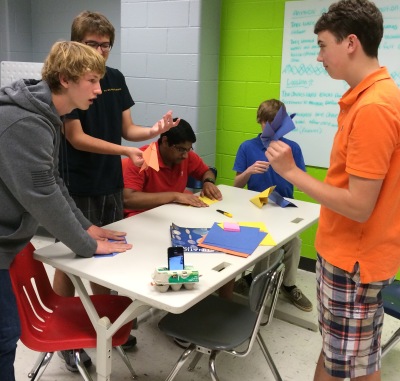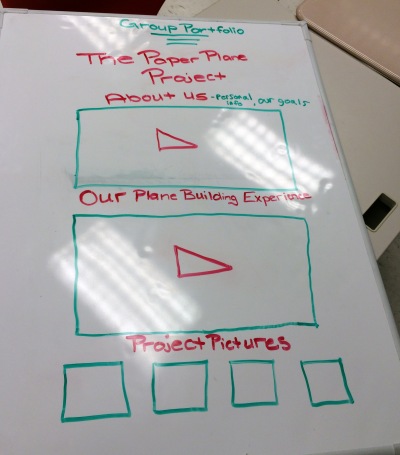This is the sixth in a series of blog posts about Maker Ed’s Open Portfolio Project work during the summer and fall 2014. These posts are also written in conjunction with the Research Briefs being released throughout the fall and winter of 2014.
 Nestled into the rolling hills of Charlottesville, VA, Monticello High School is a large, public, comprehensive high school within the Albemarle County Public School (ACPS) system, which serves Charlottesville’s urban, suburban, and rural communities. Within Albemarle, making has gained significant momentum in the past few years, spearheaded by the efforts of the superintendent, Dr. Pam Moran, and ACPS continues to pave the way in showing how an entire school district can capture the spirit of making in integrated ways.
Nestled into the rolling hills of Charlottesville, VA, Monticello High School is a large, public, comprehensive high school within the Albemarle County Public School (ACPS) system, which serves Charlottesville’s urban, suburban, and rural communities. Within Albemarle, making has gained significant momentum in the past few years, spearheaded by the efforts of the superintendent, Dr. Pam Moran, and ACPS continues to pave the way in showing how an entire school district can capture the spirit of making in integrated ways.
In the 2013-2014 academic year, Monticello High School took a bold step, instituting school-wide portfolios for its 9th and 10th graders. With every new year, the incoming freshmen start portfolios too, and soon, students at all grade levels will have a digital portfolio alongside their transcript, GPA, and standardized test scores. Notably, Monticello is a unique place, and it became a field site for our Open Portfolio Project research because, among others, its experiences provide strong insights into how portfolios are functioning within a standard school environment for administrators, teachers, and students alike.
During the 2-day site visit to Monticello, it was fascinating to be back in the hubbub of a vibrant high school community, but what stood out as particularly special is the school’s library and media center. It serves as a central hub for students and teachers alike, reaching the max capacity (per fire code) each and every day. The library is a soaring, open, sunlit space with high ceilings and a back wall full of windows. There are smaller wings to both sides and a perimeter of separate rooms. Lots of chairs, small couches, stools, desks, and low tables are scattered throughout the space, and the library also houses a music recording studio, a makerspace, a hackerspace, and many other multi-use, interdisciplinary spaces where students hang out and work and where teachers often bring classes. The library, with a front help desk filled with gadgets, half-finished projects, and a 3D printer being troubleshooted, is a prime space for making, but making happens throughout the school on a daily basis, whether in Monticello’s official shop space, in the library, or in classrooms that range from art to computer science to cooking and math.
Monticello’s portfolios are designed and developed on Google Sites, a default platform that faculty are starting to realize may be more challenging than originally anticipated. Creating pages, adding artifacts, building menus — these are technically difficult for both students and teachers to do, requiring more training and support. A Google template site is provided to all students, who are allowed to customize it as they see fit. Administrators at the high school readily admit that not all staff are on-board, though many teachers are excitedly thinking about the best ways in which portfolios will enable deeper learning. Individual classes at Monticello, such as Photography and even Culinary Arts, have portfolio or portfolio-like practices already, and other reflection and curation practices are in place in certain subjects.
 One element of our field site visits is a series of design workshops, in which both students and teachers make paper airplanes while also capturing their process of making. The results and conversations afterward highlight some of the patterns we’re seeing arise from portfolio work; in many places, it’s clear that the product and focus shift away from being on the paper airplane and towards the video, photos, or text that document the process. Similarly, though process isn’t necessarily an original focus from the start, once participants start thinking about it, they begin to discuss how it may be more important than the final result.
One element of our field site visits is a series of design workshops, in which both students and teachers make paper airplanes while also capturing their process of making. The results and conversations afterward highlight some of the patterns we’re seeing arise from portfolio work; in many places, it’s clear that the product and focus shift away from being on the paper airplane and towards the video, photos, or text that document the process. Similarly, though process isn’t necessarily an original focus from the start, once participants start thinking about it, they begin to discuss how it may be more important than the final result.
Anecdotes from teachers and students also show the successes and continued challenges that surround the implementation and use of portfolios. Some students want to think harder about what goes into their portfolio, expressing interest in planning out which work — indicative of a their experiences, interests, or growth — might be best for the portfolio. Students also commented that they could see benefitting from the sharing of portfolios with peers, whether to learn from each other’s processes or using other portfolios as a standard of comparison. In connection, some teachers also mention that it might be best for students to simply capture and archive ALL of their work. If students are making so much stuff and creating so much content for their portfolio that they can then curate what to show, that’s an ideal problem to have! In that vein of open portfolios, one particular point of Monticello’s emphasis is to ensure that students have continued access to their work, whether personal or school-related.
At Monticello and within Albemarle, the passionate administrators, librarians, central office staff, teachers, and students continue to prototype and test their portfolio implementation, eager to learn from others as well as draw insights from their own experiences. We can’t wait to see what develops.




Leave a Reply